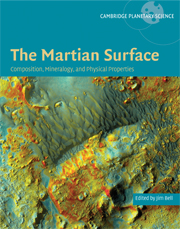Book contents
- Frontmatter
- Contents
- List of contributors
- Foreword
- Acknowledgments
- Part I Introduction and historical perspective
- Part II Elemental Composition: Orbital and in situ Surface Measurements
- Part III Mineralogy and Remote Sensing of Rocks, Soil, Dust, and Ices
- 7 Mineralogy of the Martian surface from Mars Express OMEGA observations
- 8 Visible to near-IR multispectral orbital observations of Mars
- 9 Global mineralogy mapped from the Mars Global Surveyor Thermal Emission Spectrometer
- 10 The compositional diversity and physical properties mapped from the Mars Odyssey Thermal Emission Imaging System
- 11 Mars' crustal magnetization: a window into the past
- 12 Multispectral imaging from Mars Pathfinder
- 13 Mars Exploration Rover Pancam multispectral imaging of rocks, soils, and dust at Gusev crater and Meridiani Planum
- 14 The mineralogy of Gusev crater and Meridiani Planum derived from the Miniature Thermal Emission Spectrometers on the Spirit and Opportunity rovers
- 15 Iron mineralogy and aqueous alteration on Mars from the MER Mössbauer spectrometers
- 16 Magnetic properties of Martian surface materials
- 17 Martian meteorites as crustal samples
- Part IV Physical Properties of Surface Materials
- Part V Synthesis
- Part VI Summary, Upcoming Missions, and New Measurement Needs
- Index
- Plate section
- References
8 - Visible to near-IR multispectral orbital observations of Mars
from Part III - Mineralogy and Remote Sensing of Rocks, Soil, Dust, and Ices
Published online by Cambridge University Press: 10 December 2009
- Frontmatter
- Contents
- List of contributors
- Foreword
- Acknowledgments
- Part I Introduction and historical perspective
- Part II Elemental Composition: Orbital and in situ Surface Measurements
- Part III Mineralogy and Remote Sensing of Rocks, Soil, Dust, and Ices
- 7 Mineralogy of the Martian surface from Mars Express OMEGA observations
- 8 Visible to near-IR multispectral orbital observations of Mars
- 9 Global mineralogy mapped from the Mars Global Surveyor Thermal Emission Spectrometer
- 10 The compositional diversity and physical properties mapped from the Mars Odyssey Thermal Emission Imaging System
- 11 Mars' crustal magnetization: a window into the past
- 12 Multispectral imaging from Mars Pathfinder
- 13 Mars Exploration Rover Pancam multispectral imaging of rocks, soils, and dust at Gusev crater and Meridiani Planum
- 14 The mineralogy of Gusev crater and Meridiani Planum derived from the Miniature Thermal Emission Spectrometers on the Spirit and Opportunity rovers
- 15 Iron mineralogy and aqueous alteration on Mars from the MER Mössbauer spectrometers
- 16 Magnetic properties of Martian surface materials
- 17 Martian meteorites as crustal samples
- Part IV Physical Properties of Surface Materials
- Part V Synthesis
- Part VI Summary, Upcoming Missions, and New Measurement Needs
- Index
- Plate section
- References
Summary
ABSTRACT
This chapter reviews observations and interpretations since the 1990s from orbital telescopic and spacecraft observations of Mars from the extended visible to short-wave near-IR (VNIR) wavelength range. Imaging and spectroscopic measurements from the Hubble Space Telescope (HST), Mars Global Surveyor Mars Orbiter Camera Wide Angle (MGS MOC/WA) instrument, Mars Odyssey Thermal Emission Imaging System Visible Subsystem (THEMIS-VIS), and Mars Express High Resolution Stereo Camera (MEx HRSC) and Observatoire pour la Minéralogie, l'Eau, les Glaces et l'Activité (OMEGA) have been acquired at spatial scales from global-scale ∼ 1 to hundreds of kilometers resolution to regional-scale ∼ 20–100 m resolution. Most high-albedo regions are homogeneous in color and thus, likely, composition, a supposition consistent with the long-held idea of the presence of a globally homogeneous aeolian dust unit covering much of the surface. Despite the presence and ubiquity of dust, these measurements still reveal the presence of significant VNIR spectral variability at a variety of spatial scales. For example, color variations and possibly mineralogic variations have been detected among small-scale (tens of meters) exposures of light-toned outcrop and layered materials in Meridiani Planum, Valles Marineris, and other areas. Within low-albedo regions, much of the observed color variability appears simply related to different amounts of covering or coating by nanophase ferric oxide-bearing dust and/or ferrous silicate-bearing sand. Some VNIR color units, however, in regions spanning the full range of observed surface albedos, correlate with geologic, topographic, or thermal inertia boundaries, suggesting that either composition/mineralogy or variations in physical properties (e.g., grain size, roughness, packing density) influence the observed color.
- Type
- Chapter
- Information
- The Martian SurfaceComposition, Mineralogy and Physical Properties, pp. 169 - 192Publisher: Cambridge University PressPrint publication year: 2008
References
- 9
- Cited by

